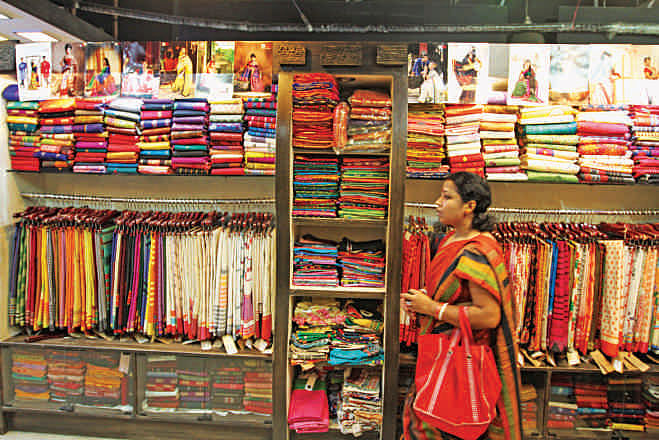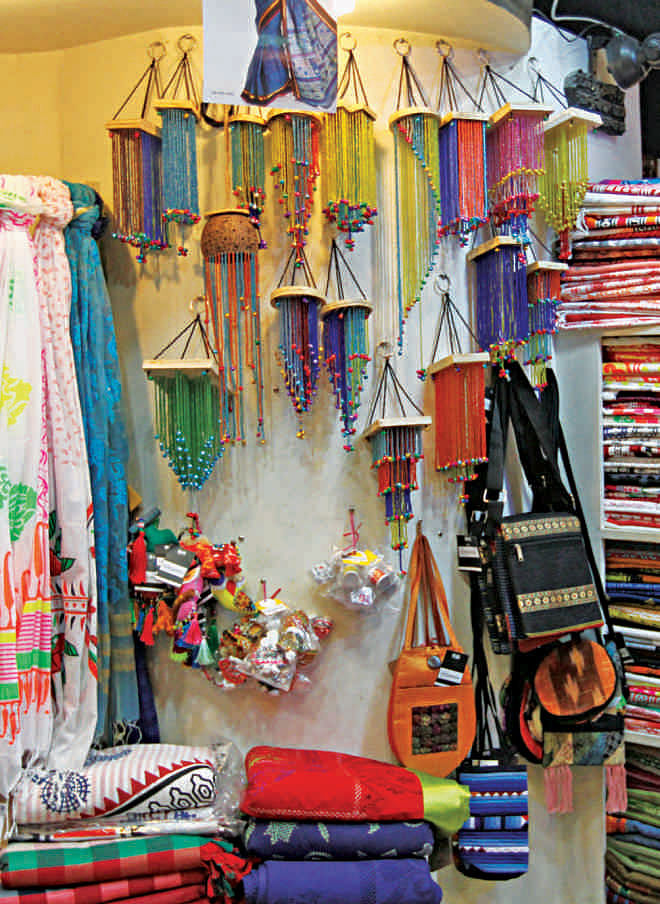DESHI IS THE NEW SEXY


“Last Eid we were invited to attend a family get-together at my aunt's place. While Eid get-togethers are mostly about having a grand feast and sharing happiness, it is equally about holding up the best look and also secretly scrutinising everyone's attires.
Within the next hour many of my fashion forward first cousins, distant cousins, aunts and distant aunts arrived wearing dresses of similar designs and patterns, claiming that they were wearing “original lawn suits” designed by famous Pakistani designers, namely Sana Safinaz, Gul Ahmed, Asim Jofa and Al Karam.
As I eyed them, I found that most of them, if not all, were wearing stitched floral printed long kamizes with machine embroidery on the front, with a satin panel at the hem, with sleeves that seemed to have been cut from some other dress, finishing the look with a pair of palazzos and printed chiffon dupattas.
“This is an original Al Karam (a pakistani clothing brand),” proudly announced one to the other, with an air that suggested she 'only-wears-original-brands.'
They would have generally balked at the idea of showing up at a party in the same outfit as some other person. However, they were too caught up in the “international designer” act to be aware how these “designer lawn” suits boasting homogenous patterns and designs made them look like identical twins who would be dressed up in similar outfits as kids by their horents.

And then my eyes turned to one of my cousin's muslin dress which had an intricate hand-embroidery print on it paired with a jamdani dupatta and matching accessories that completed her delicately graceful look and made her stand out in the crowd. After further investigation, I found out that her beautiful outfit came from a popular deshi fashion house.
Frankly, we don't have any grudges against Pakistani or Indian clothes. It is undeniable that for decades, dresses worn by mainly Indian actresses influenced fashion trends in our country, say our deshi designers.

“There is no harm in wearing outfits conceived foreign designers, but that does not mean that we should ignore our native designs that retain our culture, heritage and originality,” comments Emdad Haque, one of the pioneer fashion designers of the country and the owner of Studio Emdad.
Moreover when it comes to long awaited national festivals like Eid and Puja, we don't want to look homogenous and boring, do we?
That's where our deshi fashion designers come into the picture. They work arduously all yearlong to bring you unique outfits, blended with the latest trends and traditional fabrics, thus enabling you to make a style statement on these special occasions.
Hence before you begin your hunt for the dream dress in the piles of Pakistani designers' lawns or in the rows of similar Indian designs hung at window displays of most shops, try to discover what our deshi designers have in store for you and find out what style is your perfect fit.

For ages Bangladeshi fabrics like muslin, jamdani, tant, khadi and silk have been ranked among the best in the world.
“In last thirty years our designers have brought about a renaissance in Bangladeshi fashion making every effort to keep our heritage alive by giving it a contemporary look,” opines Biplob Shaha, the designer and owner of the ever expanding fashion house Rang.
Today we have boutique houses like Aarong, Rang, Mayasir, Anjan's, Aranya, Jatra, Shadakalo, Deshal, Studio Emdad and many more, including countless home-based stores who are reviving our local haute couture and are also playing an instrumental role in making a positive impact on the lives of local weavers, craftsmen and artisans.
Unfortunately the primary struggle facing nearly our every deshi fashion house is the invasion of various Indian and Pakistani fashion designs. With Durga Puja and Eid-ul-Azha approaching fast, local markets have been flooded with Indian clothes, a good number of those are named after popular Indian television serials, movies, actresses and even catchphrases.


Remember the 'Pakhi dress?' Last Eid, this dress as shown in the Star Jalsha serial Bojhena se Bojhena, was termed as the dressed to die for by many local clothing stores. The hype and obesession surrounding this dress was so much that it reportedly resulted in at least three deaths and one divorce. Like this outfit, many other Indian serials and popular film characters have been dictating terms in the latest trends, thus leading to a new, unfortunate era in couture in our local fashion scene. All hail the power of the satellite!
“The young girls who are ardent fans of Indian serials and films tend to follow the dressing styles of the protagonists so much that they go to the markets and blindly pick that dress without even checking out what the deshi designers have to offer,” Biplob elaborates. “Cultural aggression is responsible for making these dresses with peppy names popular to our people.”

Aarong has certainly been ruling the Eid market especially when it comes to their panjabi selection. “Apart from having our regular customer base, during Eid we cater to a larger group of clients who prefer buying their panjabis from Aarong,” says Mohammad Abdur Rouf, Chief Operating Officer of the renowned fashion house.
“However, in last two to three years we have noticed that many of our panjabi buyers were interested in buying Indian and Pakistani designs. The satellite dominance and the exposure to Pakistani and Indian online pages on social media are the reasons behind this.”
While Biplob agrees that satellite is responsible for seizing the fashion market, he also adds that the people of the country are equally accountable as they do not believe in anything that has a deshi essence.
“As a nation we have this tendency of preferring foreign products over our own,” he says with disappointment. “Our affinity towards foreign products, be it a pair of earrings or a dress, boosts our desire to consume a copy of Pakistani designer set or an Indian Anarkali dress,” he adds.
The affordable price of these imported dresses is also a major factor to opt for them, agree both fashion designers and customers.
“These dresses are brought into the country by paying a meager import tax, therefore the importers and suppliers can sell them at a reasonable price,” Emdad says in anger.

“There are two kinds of products in the market, one is mass produced local industry and the other is designer wear. Designer wear of every country is bound to be expensive since they are much more personalized and has a unique, specialized thought process behind them,” comments Maheen Khan, one of the country's pioneer designers and the owner of fashion house Mayasir. “Why we, the Bangladeshi designers need to compete with the foreign mass produced clothes and compromise with our price and quality?”
“In many cases, the importers sell them online and through fairs and exhibitions which decreases their establishment costs,” Rouf adds. “On the other hand, we deshi designers need to involve a group of stakeholders - for example, weavers, artisans, hand embroiders - in the revenue process. As a result, unlike the vendors of foreign designs and fabrics, we cannot sell the products at a cheap rate. If they prefer Indian or Pakistani designs, consumers can get an outfit specifically designed for the festival at almost half the price of a design made by a local fashion house. So the buyers might not find the products affordable and we can't blame them.”
Our native fashion designers' impeccable designs and creations has helped us reach the glory and success that today marks the fashion culture of Bangladesh not only in the local market but also in the global market. The influx of 'exclusive' replicas of some Pakistani designers should not make our deshi products unpopular to fashion lovers.
So what can be done to advocate the ethnic essence that our deshi fashion houses have?
“We cannot force our consumers to come buy our products,” says Maheen. “But I'd like to add that most local products are singled out for their ornate craftsmanship and hand embroidery which involves the hard work and skills of a large number of artisans.

“The media needs to be more vocal in this regard, as they can best promote deshi products and crafts persons, “Rouf adds.
“If we look at the fashion industries of our neighboring countries, we will find that their celebrities indisputably determine the rise and fall of trends in their country,” says Biplob. “But unfortunately many actors of our country tend to attend international programmes wearing foreign designs. If they prefer choosing deshi clothes like our jamdani sarees or mirpuri katan to celebrate the originality of our fabrics, their style would undeniably become an influencer for fashion conscious consumers.”
Emdad believes that the government has a huge role to play in regard to lowering productions costs. “We need to depend on foreign markets to import many raw materials, namely the fabric, borders and lace,” says Emdad. “If we could develop our own industry with the government's assistance, it could help to develop technical aspects and thus curtail our production costs.”
“Designer wears of every country is bound to be expensive since they are much more personalized and has a unique, specialized thought process behind them,” says Rouf. “However, at the same time we need to keep our customers' demand in mind. On the designers' part, we need to work on the principles of commercial viability and consumers' preference. If we want more consumers to wear deshi clothes we need to ensure that our designs are more intricate and are better in quality and most importantly, are available at an affordable rate. Instead of targeting a certain class of people, we need to open our products to a larger group of fashion-savvy clients so that they prefer deshi products over foreign ones,” he adds.
Recently, some of the prominent names of the country's fashion industry formed the Fashion Design Council of Bangladesh (FDCB), headed by designer Maheen Khan, to accelerate the growth of the fashion industry.
This not-for-profit council is working with a noble goal of coordinating and cooperating with different ministries that deals with finances and cultural affairs.
“Our council aims to promote Bangladeshi culture and fashion internationally as well as creating a market for our deshi products for local customers,” comments Maheen.
For its very nature, fashion demands to be global, experimental and culturally diverse. But at the same time we need to keep in mind that foreign cultural dominance should not surpass our individuality and tradition.
We are what we wear and nothing feels greater than stunning clothes that illustrate our culture in style with a great sense of pride and individuality. So this Eid, before you hurry to buy a Pakhi or a Goru dress, take a fashion walk around the local boutiques and enjoy the strong sense of pride in wearing something original; wearing something that carries the roots of our homeland.


 For all latest news, follow The Daily Star's Google News channel.
For all latest news, follow The Daily Star's Google News channel. 



Comments